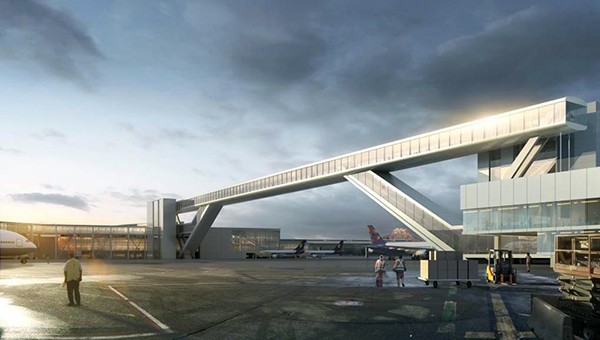The state of Washington anticipates 2.2 million new residents by 2040, and the Port of Seattle is planning for the opportunities and challenges that growth presents, Port Commissioner Stephanie Bowman told Mercer Island Chamber of Commerce members at their Sept. 8 luncheon.
The Port of Seattle should really be called Port of King County, Bowman said, as it manages international trade and travel and serves all 39 cities in the county. The port operates the Seattle-Tacoma International Airport and harbor facilities in Seattle and Tacoma, which were recently renamed the North and South Harbors after the formation of the Northwest Seaport Alliance. The port employs about 1,800 people, but there are 216,000 jobs related to port activities.
Bowman, who worked for the Port of Tacoma and Seattle Chamber of Commerce and who now manages a nonprofit and serves as secretary for the Port Commission, said that one of her goals is to learn how to better connect the port with local businesses and residents.
She said she is organizing a small business summit to help the port meet its goal of having 40 percent of contracts be from smaller businesses, and mentioned a $1 million grant program that helps cities with economic development initiatives. The grants range from $5,000 to $65,000 for eligible projects based on population, and require cities to match 50 percent of the port’s money.
“We want to support things that the local communities are doing to help themselves,” she said.
The explosive growth in the region is an opportunity for prosperity, but presents livability and equity challenges, Bowman said. The port has a broad goal: to create 100,000 new, good jobs, promoting a diverse economy while advancing trade, commerce and industrial growth.
“Anybody can create jobs, but they have to be high quality … to produce a livable community and equity for everybody,” Bowman said.
SeaTac Airport is planning for “unbelievable growth,” Bowman said, from about 44 million passengers per year to 66 million.
The airport is the port’s “biggest and most sustainable asset,” but investments in capital projects will be needed to accommodate additional travelers. Bowman said that a discussion about another regional airport could happen sooner than we think.
“I do believe that within the next five to 10 years we’re going to have that conversation about another regional airport,” she said. “It’s billions and billions of dollars of investment, [so] it’s in everybody’s interests to make the most out of the airport that we have.”
SeaTac, surrounded by a freeway, a wetland and a cemetery, doesn’t have a lot of physical room to grow. But the port is working on more than $2 billion in near-term projects, including the NorthSTAR satellite (a joint venture with Alaska Airlines), the new International Arrivals Facility, an updated baggage system and a 20 year Sustainable Airport Master Plan.
“We want to reduce the environmental footprint in all of our operations,” Bowman said.
The port is a partner on the Duwamish cleanup, is working with Boeing, Alaska Airlines and Washington State University to advance a biofuels initiative and is looking for opportunities to install solar panels on port property.
Busier ports do come with economic advantages, Bowman said. Every time a cruise ship docks in Seattle, it brings in $2.6 million in local sales tax revenue. There are opportunities for international trade, exporters and the air cargo business. Bowman used the example of Washington state cherries. They are a valuable and perishable product that do not travel in cargo containers, but in the belly of airplanes, and can fetch $1 per cherry in Asia.
There are also new opportunities for dining, concessions and retail in SeaTac, which is looking for more small businesses and “Northwest flavor,” Bowman said.
There are disadvantages as well. As the port commissioners saw Transportation Security Administration (TSA) lines at the airport get longer and longer, up to an average of 90 minutes, they hired private contractors and brought the wait back down to 20 minutes. At the seaports, boxes can be held up in traffic. Bowman noted the importance of the recently passed regional transportation package and gave a shout-out to state Rep. Judy Clibborn for her work.
But many other legislators don’t understand the issues the Port of Seattle faces, particularly with competition from other ports. Bowman said that commissioners are organizing a trip to Canada, to visit ports in Vancouver and Prince Rupert, in October. Canadian ports are closer to Asia and don’t charge a harbor maintenance tax, as the U.S. does. But the port did eliminate inter-regional competition by introducing a revenue-sharing model for the Seattle and Tacoma harbors.
Bowman said that the Port of Seattle’s advantages are customer service and the fact that it is getting several terminals — Terminal 5 in Seattle and 3 and 4 in Tacoma — big ship ready. Fuel, labor and logistics are cheaper with bigger ships, and that’s where the industry is heading, Bowman said. Even the new Panama Canal can’t handle the biggest ships today.
Other improvements to look for from the port are a new mobile app for SeaTac Airport and a moving sidewalk from the light rail station to the main terminal, Bowman said.
For more, call the Port Commission office at 206-787-3034.


